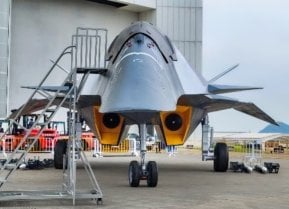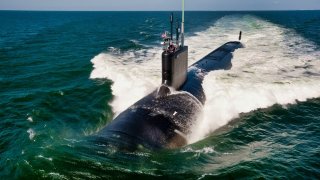Virginia-Class Submarine: $17,000,000,000 Over Budget and Years Behind
The U.S. Navy’s plan to counter China’s military buildup by 2027 faces significant hurdles, particularly with the Virginia-class submarine program. Delays have pushed completion timelines by 2-3 years, and cost overruns exceed $17 billion.
What You Need to Know: The U.S. Navy’s plan to counter China’s military buildup by 2027 faces significant hurdles, particularly with the Virginia-class submarine program. Delays have pushed completion timelines by 2-3 years, and cost overruns exceed $17 billion.
-Contractors General Dynamics and Huntington Ingalls Industries are producing only 1.2 subs annually, far short of the two-per-year goal, with a target for improvement by 2028.
-These delays threaten U.S. readiness and commitments under the AUKUS alliance.
Virginia-Class Sub Delays: A Threat to U.S. Naval Readiness Against China
Compounding the issue, shipyard closures and skilled labor shortages hinder production capacity. The Navy must address these challenges urgently to meet its objective of having 80% of its fleet battle-ready by 2027.
Back in September, the United States Navy announced that it was adopting a new strategy to counter the military buildup underway in China, The sea service's "Navigation Plan for America's Warfighting Navy" calls for it to be prepared for a possible conflict with the People's Republic of China before the end of the decade.
"By 2027, the Navy will be more ready for sustained combat as part of a Joint and Combined force, prioritizing the People's Republic of China as the pacing challenge," the report stated.
The timeline is "directly linked to Chinese President Xi Jinping’s goal of having the PLA capable of invading Taiwan by 2030," Marine Insight reported. The U.S. Navy seeks to have upwards of 80% of its fleet battle-ready by the deadline.

However, it seems that the U.S. Navy may have its work cut out for it, with several hurdles to clear to reach its goals. Among those is the latest block of Virginia-class nuclear-powered fast attack submarines, which is now projected to cost more than $17 billion over the planned budget through the end of the decade.
This is "a problem emblematic of a crisis in the program," Bloomberg reported, citing the House's top lawmaker on defense spending.
"It's clear that the Navy and shipbuilders have known about this shortfall for at least 18 months [but] Congress was notified just two weeks ago," Rep. Ken Calvert (R-Calif.), chairman of the House Defense Appropriations subcommittee, said in a statement before last Thursday's classified hearing with U.S. Navy Secretary Carlos Del Toro.
Virginia-class Boats Running Late
The United States Navy has seen significant delays with the Virginia-class boats, and the latest subs are not two to even three years behind schedule while the prices continue to increase.
Calvert further suggested the Virginia class is just one of several U.S. Navy programs that are "in crisis," and he strongly criticized the sea service for its failure to disclose the problems.
"It's not clear to me that anyone has accurate information about the trajectory of any shipbuilding program other than the program executive officers and since they switch out every two years, the options for long-term accountability are limited," Calvert added. "For too long, this committee has been put in a position of asking what the Navy is hiding behind the curtain. It's time to pull down the curtain altogether."
The two prime contractors for the Virginia-class submarines, General Dynamics and Huntington Ingalls Industries (HII) were contracted to build two submarines a year, but as Bloomberg reported, the defense firms are only "averaging the completion of one plus 20% of the work building a second submarine."
It is now estimated that the companies "won't hit the two-a-year rate until by 2028," and more worrisome is that the delays won't just impact the U.S. Navy, but could "undermine" the AUKUS alliance with Australia and the UK, as the U.S. was charged with selling Canberra the first of as many as five Virginia-class boats beginning in 2032.

All About That Base
The U.S. Navy has acknowledged the issue, but in a statement following the hearing, the service said it "has been advocating for improvements to the maritime industrial base, and to increase funding to ensure the Navy meets its acquisition objectives."
For its part, the Navy has set up "an independent Naval Cost Agency to improve cost estimations and created a Maritime Industrial Base program to manage the funding supporting the industrial base."
The root of the problem is easy to see. Since the 1970s, 14 "defense-related shipyards" have been shuttered, while only one new shipyard has opened. In addition, the number of firms still in the shipbuilding sector has dwindled. Moreover, the shipbuilding industry is facing an ongoing challenge to attract, train, and retain skilled labor. Just as the U.S. military has struggled to fill its ranks, the shipbuilding industry is facing a very serious labor shortage. There are not enough new workers to replace those who are retiring.
Given these issues, the U.S. Navy may need to rethink how it will be able to be ready to take on China in just over two years.
Author Experience and Expertise: Peter Suciu, Defense Expert
Peter Suciu is a Michigan-based writer. He has contributed to more than four dozen magazines, newspapers, and websites with over 3,200 published pieces over a twenty-year career in journalism. He regularly writes about military hardware, firearms history, cybersecurity, politics, and international affairs. Peter is also a Contributing Writer for Forbes and Clearance Jobs. You can follow him on Twitter: @PeterSuciu. You can email the author: [email protected].
Image Credit: Creative Commons and/or Shutterstock.


